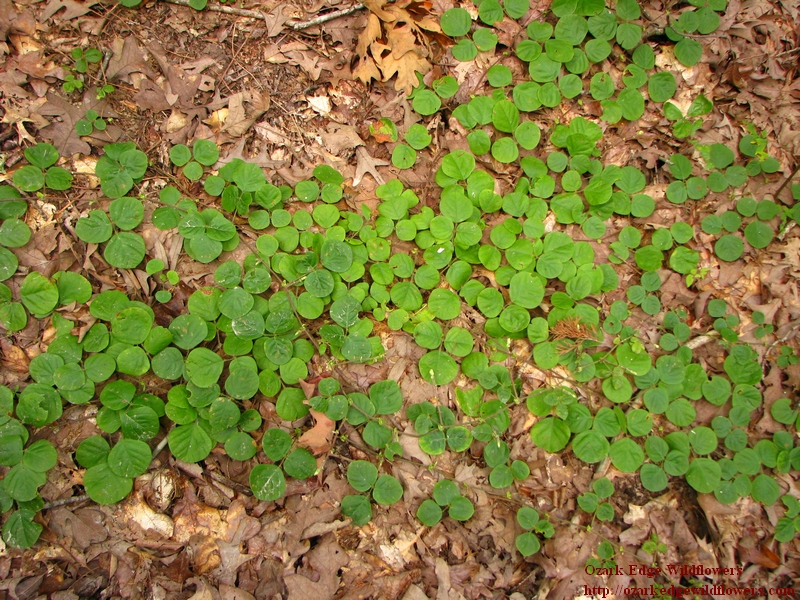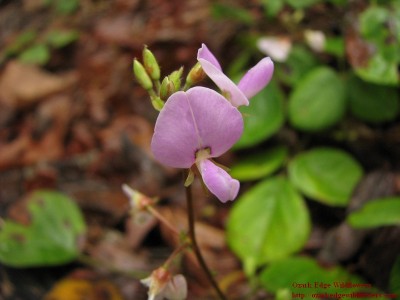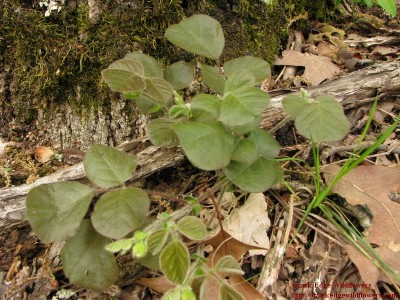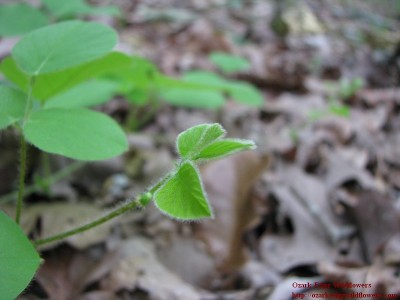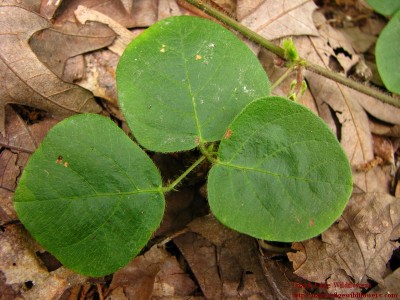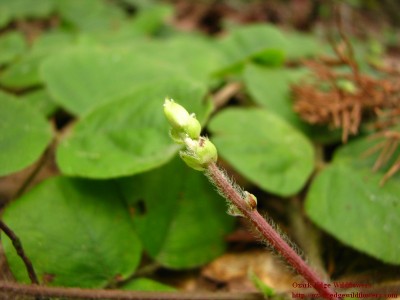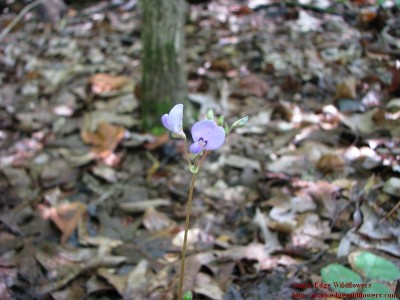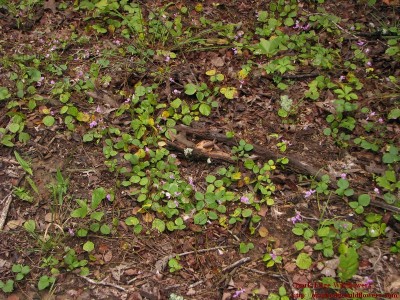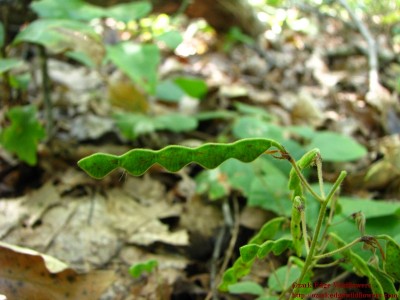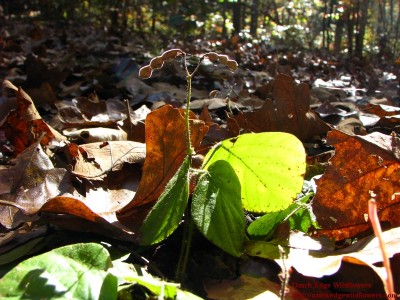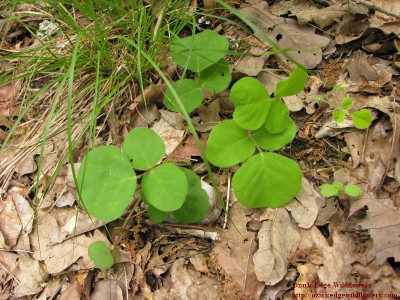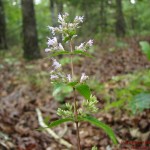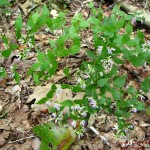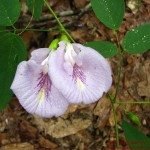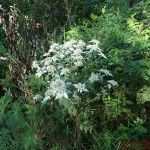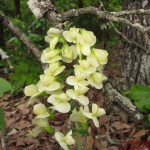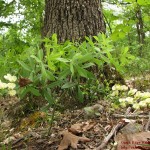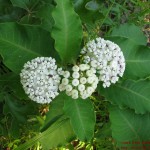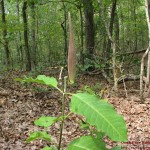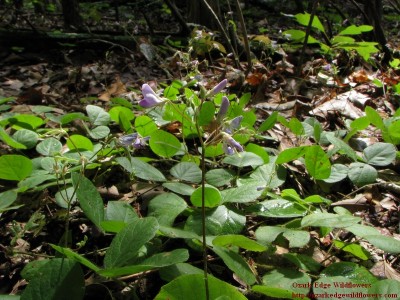The soft round leaves of Desmodium rotundifolium form interesting patches of carpet in the woods. Each carpet is a pattern of green circles atop a brown mosaic (leaf litter). Small pink flowers appear above the green circles in late summer. You might not notice this little ground cover, but others do–deer, turkey, bobwhite, ruffled grouse and other animals know that this unobtrusive plant is an important food source. It can be a bit surprising to learn that many of the plants most valued by wildlife are little noticed by humans. I think this usually happens when plants are small or lack showy flowers. The more knowledge I absorb about the relationship between our native plants, insects, birds and mammals, the greater appreciation I have for natures web of interdependence. On its own, the simple beauty of Desmodium rotundifolium is enough to deserve our admiration, but it is even more deserving when we understand its important role in feeding our birds and mammals.
Latin Name/Common Name- Desmodium is a large family of legumes with nearly 30 species in the southeast US. Most Desmodiums are upright plants, but this is one of the two trailing species. The genus name Desmodium arises from the Greek word, “desmos” meaning band or chain. This describes the pea-type seedpods. The word rotundifolium comes from two Latin words, “rotund” meaning round and “folium” meaning leaf.
Common names include Dollar leaf, Prostrate tick trefoil and Flux Vine. The name Flux vine came from the reported ability of Desmodium rotundifolium to stop dysentery.
Bloom Color- The flower of Desmodium rotundifolium is papilionaceous, meaning “butterfly-shaped”. This is typical of nearly all flowers in the legume or pea family. These flowers are composed of five petals. The large upper petal is known as the standard or banner. There are two side petals, which are known as wings. The keel is the front part, usually inside the wings. It contains the stamens and pistal.
The color of Desmodium rotundifolium is soft pink or purple with maroon markings just in front of the wing. The flowers are small with the standard being about 1 cm and the keels and wing just under a centimeter. The flower stem rises above the leaves and each stem produces an inflorescence containing multiple flowers.
Soft pink to purple bloom
Description- This plant is a perennial, trailing vine growing on the woodland floor. The leaves appear alternately on a hairy stem. Each leaf is composed of 3 round to oval shaped leaflets. The leaflets are soft to the touch, being covered in fine, long hairs. The seed pods, shaped like a pea or bean, are held above the leaves on short stems. They appear in early fall and ripen in November.
Early growth with soft, new leaves in April
Close view of tender spring growth
Single leaf composed of 3 roundish leaflets
Flower bud in July
Erect stem with flowers in August
Pink flowers dotted among the green leaves
Young seedpod in October
Ripe seed pod in November
Bloom Time On Ozarkedge, Desmodium rotundifolium begins blooming late July and continues flowering into September. The seedpods ripen during October/November.
Habitat Dry, rocky woods are the preferred habitat. Desmodium rotundifolium can be found happily growing in the leaf litter of dense to semi-shaded areas at the woodland edges.
Deciduous woods are the preferred habitat of Desmodium rotundifolium
What’s Growing Nearby? There are few plants blooming in the deep woods during August and September. Below are a few you might see either in bloom or with interesting foliage near Desmodium rotundifolium. All of these flowers are found on Ozarkedge.
Cunila origaniodes (Dittany) blooms in a similar habitat and time
Clitoria mariana and Pycnanthemum albescens share both habitat and bloom time with Desmodium rotundifolium
Baptisia bracteata (Cream wild indigo) grows alongside Desmodium rotundifolium, but blooms in the spring
Asclepias variegata (Variegated milkweed) blooms in spring but has an interesting seedpod in late summer
Endangered List- Desmoidum rotundifolium is on the state endangered list in New Hampshire and Vermont. The USDA plant site lists it as Endangered in both New Hampshire and Vermont.
Natureserve indicates it is Possibly Extirpated in West Virginia and Critically Imperiled in Kansas and Vermont. It’s Imperiled in New Hampshire. Fortunately Kentucky, North Carolina and Virginia indicate it is Secure and New York shows as Apparently Secure. All other states are Unranked.
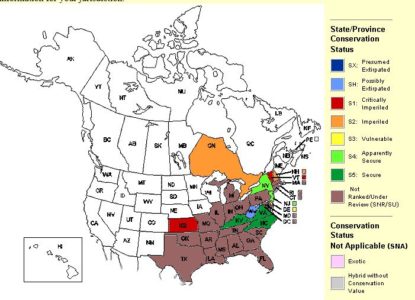
*NatureServe. 2018. NatureServe Explorer: An online encyclopedia of life [web application]. Version 7.1. NatureServe, Arlington, Virginia. Available http://explorer.natureserve.org. (Accessed: March 9, 2019 ).
Interesting Tidbits- Sometimes planted in mixes for wildlife, Desmodium rotundifolium is a nitrogen fixer as well as an important source of food for wildlife. Deer browse the leaves, bobwhite, turkey and ruffled Grouse consume the seeds. It is a larval host plant for the Variegated Frittilary butterfly (Euptoieta claudia) and the Southern Cloudywing (Thorybes bathyllus).
